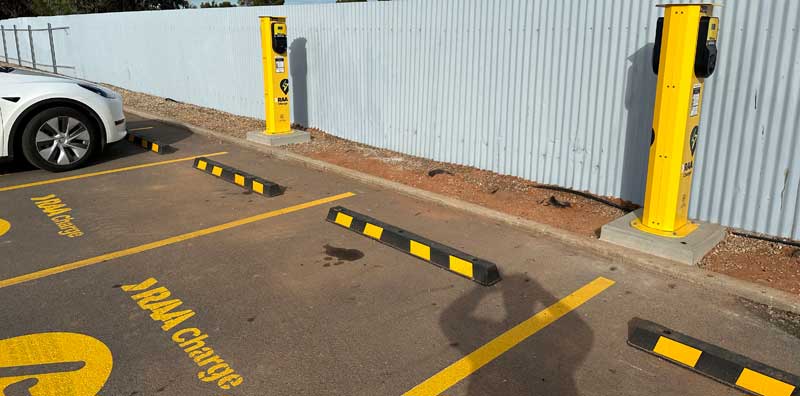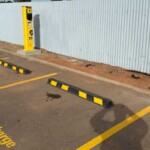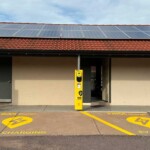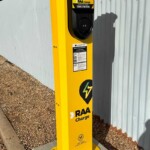The RAA was granted $12.35 million by the State Government to construct an electric vehicle charging network across the state. They proudly claim that their network is crucial for interstate and intrastate connectivity, long distance travel, and tourism. They promise to offer fast, rapid, and ultra-rapid chargers. However, the reality falls far short of these expectations. The recent EV charging stations installed by the RAA in Whyalla are nothing but a mockery. Located at the rear of the Sundowner Hotel and Comfort Inn, these chargers are actually slow destination chargers with a power output of only 7Kw.
These chargers are not suitable for “interstate and intrastate connectivity, long distance travel, and tourism” as advertised. It would take a staggering 4 to 8 hours to charge an electric vehicle using these chargers. Their utility is limited to overnight guests at the Sundowner Hotel or Comfort Inn who wish to charge their EVs. One must question the rationale behind allocating $12.35 million of government funds to the RAA for such a localized and inefficient charging solution. Instead, the responsibility of installing destination chargers for their patrons should lie with the Sundowner or Comfort Inn, not the State Government.
Now, let’s consider a scenario where a long-distance traveller arrives in Whyalla and requires a charge for their electric car. Unless they have an ample amount of time to spare, they will be sorely disappointed. Additionally, they would need to provide their own charging cable since it is not supplied. To put it in perspective, imagine arriving in Whyalla in a gasoline-powered car, needing 60 litres of fuel to continue your journey. You pull up to a pump and discover that it dispenses only 7 litres of fuel per hour, meaning it would take 8.5 hours to fill your tank and resume your trip. And before you can even do that, you must provide your own hose to pump the fuel. This situation is undeniably laughable.
Thankfully, there is a ray of hope in the form of a two-station rapid DC charger located at the Whyalla Veterinary Clinic. This charger, unlike the RAA’s installations, was funded and installed without any government assistance. It can charge an electric vehicle in under an hour, allowing travellers to quickly refuel and visit Westland’s for a coffee before hitting the road. Moreover, the veterinary clinic has its own destination chargers for their vehicles, once again without relying on government funds or support.
Consider this: with $12.35 million, it would be possible to build 120 DC Fast charging stations capable of simultaneously charging 240 cars within 30 to 60 minutes. This information is not hypothetical; such a charging station has already been constructed. If an organization were genuinely committed to establishing a top tier charging network for EVs on the move, this is the kind of infrastructure they could provide.
To evaluate the RAA’s dedication to EVs, one need only examine their carefully worded Q&A. While it appears extensive, there is a glaring omission. The most crucial question for EV owners on the move is conspicuously absent: “How long will it take to charge my electric vehicle?” This oversight speaks volumes about the RAA’s true commitment to supporting electric vehicles.





Charging infrastructure for West Australians planning to travel to SA is virtually non-existent between the border and Adelaide with no hope in sight. Abysmal!
Dear WVC, a well-written article and echoes my own opinion of RAA and their apparent inability to properly manage this important, publicly funded project. I have had several conversations with the RAA, written to the State government ministers for Transport and for Tourism and they do not seem to be technically competent or even aware of the issues for EV owners in SA. I am particularly irked by their advertising which claims “fast” chargers are being rolled out. I have pointed out to them that the industry term for “fast charger” refers to 50kW d.c. chargers and greater and it is misleading to call a 7kW a.c. charger “fast.” I have had no response to this as their advertising experts continue to mislead the public. I wonder if the local councils are aware of the damage to tourism this RAA mismanagement is causing to the region? I fully expect the $12m will disappear in administration and advertising costs instead of building strategically placed d.c. fast chargers. Congratulations and heartfelt thanks to you and your team.
I concur. 7kw is something I can achieve at home off my Solar with Phase 1 Charger installed. The RAA should have atleast provided Phase 3 with 22kw which would charge the average 60kw vehicle in less than 3hrs. This would have filled the void between home charging and fast charging as 3 Phase Power is not something we all have at home. Most of us will charge from our solar where and when possible, but when traversing about the country we then must choose between RAA Charger and alternative Fast Chargers that actually are fast. At 22kw I could see myself sometimes using the RAA Chargers, while other times using the Fast Chargers located at the Vet Clinic when I need the fuel faster. As it is I don’t see myself ever using the RAA Chargers because we can achieve 7kw at home. And when I travel I want to keep moving so will choose the fast charge options.
In NSW’s the NRMA has rolled out 50kw Chargers free of charge to Members and non Members, soon to change at the end of this year. The NRMA has done this I think for the past 5yrs providing an incredible service making the rollout of EV’s even possible. I will absolutely choose NRMA when they rollout through SA and make my appreciation shown
Crony Capitalism, Socializing the Costs and Privatizing the Profits!
I agree. Purpose of SA Gov subsidy to RAA is to promote EV purchase and use. Slow 7 kW chargers do not achieve this stated goal for those with no off street parking and or no home charger possibility